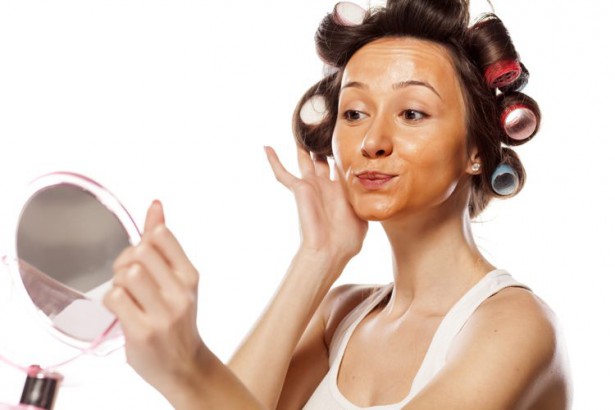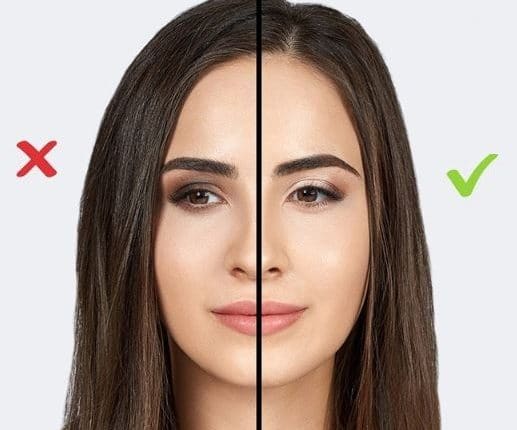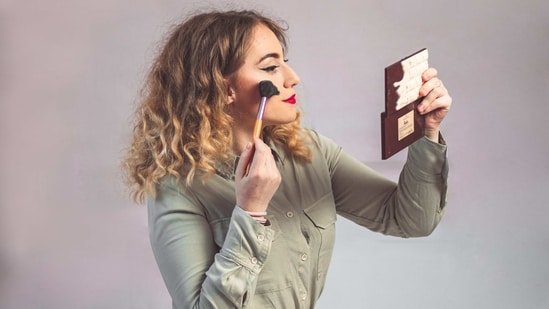In the world of beauty and cosmetics, applying makeup is both an art and a science. While it offers us the canvas to express our individuality, it also requires knowledge and technique to ensure we are enhancing, not detracting from, our natural beauty. Just as important as learning the right makeup methods is understanding common makeup mistakes.
These mistakes, often borne out of habit, misinformation, or a lack of knowledge, can impede your journey towards a flawless makeup routine. In this guide, we will illuminate 15 common makeup mistakes to avoid, providing you with the insights and tools necessary to elevate your makeup application skills and achieve that desired look.
1. Using the Wrong Foundation Shade
Choosing the right foundation shade is crucial to achieving a natural and radiant makeup look. However, a common makeup mistake many make is using a shade that’s too light or too dark for their skin tone. This creates an unnatural contrast between the face and the rest of the body, often leading to a noticeable ‘mask-like’ effect. To avoid this, it’s essential to match your foundation to your skin tone accurately. Testing the foundation on your jawline under natural light can help you find the perfect match. Remember, our skin tone can change with seasons, so it may be necessary to have different foundation shades for different times of the year.

2. Overdoing the Bronzer
Bronzer can give your skin a warm, sun-kissed glow, but overdoing it can create an unnatural, muddy appearance. A common makeup mistake is applying bronzer all over the face instead of strategically placing it where the sun naturally hits — the forehead, cheekbones, and bridge of the nose. Using too dark a shade can also make your skin look orange. Makeup mistakes to avoid , choose a bronzer one or two shades darker than your skin tone and use a fluffy brush for a softer, more diffused application. Remember, the goal of using bronzer is to achieve a subtle, healthy glow, not to dramatically alter your skin color. Less is always more when it comes to bronzer.
3. Neglecting Eyebrow Shaping
Eyebrows frame the face and play a significant role in your overall look, but they are often neglected or improperly shaped. A common makeup mistake is over-plucking or over-filling the brows, which can create a harsh, unnatural appearance. Remember that eyebrows are sisters, not twins — they don’t need to be perfectly symmetrical. Instead, aim for a shape that complements your face.
Always use a light hand when filling in your brows with a pencil or powder, and aim for a color that matches or is slightly lighter than your natural brow color. Brush through with a spoolie to distribute the product evenly and create a softer look. Properly groomed eyebrows can enhance your features and give your face a balanced, harmonious appearance.
4. Using Too Much Concealer
Concealer is a magical tool that can hide blemishes, redness, and dark circles, but using too much can create a caked-on effect, drawing more attention to these areas. One common makeup mistake is applying concealer before foundation, which often leads to using more product than necessary. Always apply your foundation first to see what areas need additional coverage, then apply a minimal amount of concealer only on those spots.
Choose a shade that matches your skin tone exactly for blemishes and redness, and a slightly lighter shade for under-eye circles. Don’t forget to gently blend, preferably with a damp beauty sponge, to prevent creasing and ensure a natural, skin-like finish. A little goes a long way with concealer, and using it wisely will result in a flawless complexion.
5. Skipping the Primer
The primer is an often overlooked yet critical component in a makeup routine. It serves as a base for foundation or eyeshadow, helping to smooth the surface of the skin, minimize pores, and ensure that your makeup lasts longer.
Skipping primer is a common makeup mistake that can result in uneven foundation application, premature makeup fading, or exacerbation of skin texture issues. Primers come in different formulations, so choose one that suits your skin type. For oily skin, a mattifying primer can help control shine, while hydrating primers can be beneficial for dry skin. An illuminating primer can provide a glowing base for makeup. Remember, a small amount of primer can make a significant difference in the longevity and finish of your makeup.

6. Incorrect Use of Lip Liner
Lip liner is a fantastic tool that can define your lips, enhance their shape, and prevent your lipstick from feathering. However, incorrect use can detract from your look. A makeup mistake is applying a darker lip liner than the lipstick shade, creating an unflattering contrast. Aim for a lip liner that matches your lipstick or natural lip color for a seamless look.
Additionally, don’t just outline the edges of your lips and leave the rest bare; this can result in a noticeable line as your lipstick wears off. Instead, fill in your entire lip with liner before applying lipstick. It creates a base that will help your lipstick last longer and maintain a consistent color throughout the day.
7. Applying Mascara to Bottom Lashes First
Applying mascara to your bottom lashes first might seem innocuous, but it can inadvertently create a makeup mishap. When you look up to apply mascara to your upper lashes afterward, the wet mascara on your lower lashes can smudge against your skin, creating a messy under-eye area. To avoid this, always apply mascara to your upper lashes first. Let it dry and then proceed to your lower lashes. This order of application minimizes the risk of smudging and ensures a cleaner, more polished look. Remember, every step in your makeup routine matters, even the sequence of applying products. Mastering these little details can elevate your overall look significantly.
8. Neglecting Neck and Decollete Makeup
The neck and décolleté are often overlooked during makeup application, resulting in a mismatched face and body complexion. When applying foundation or any form of base makeup, it’s crucial to blend the product into your neck and décolleté area. This step ensures a seamless, natural transition and avoids the dreaded “floating head” look, where the face appears disconnected from the body due to color differences. Remember, makeup is not just about enhancing your facial features, it’s about creating a cohesive, harmonious look from face to chest. Extend your beauty routine below your chin for a more polished and professional makeup look.
9. Not Regularly Cleaning Your Brushes
One of the most common yet overlooked makeup mistake is not regularly cleaning your brushes. This not only affects the performance of your makeup tools, but it’s also a hygiene concern. Dirty brushes can become a breeding ground for bacteria, leading to potential skin breakouts, infections, and an inconsistent application of makeup. It’s recommended to clean your brushes at least once a week using a mild cleanser or a designated brush cleaner. Regular cleaning will not only prolong the life of your brushes, but it will also help keep your skin healthy and clean, ensuring your makeup always looks its best.
10. Applying Blush Incorrectly
One of the classic makeup blunders is the incorrect application of blush, which can drastically affect your overall look. Many individuals tend to apply blush over a large area or in the wrong place, giving an unnatural flush or even a clownish appearance. Blush should be applied subtly on the apples of the cheeks, blending outward and upward towards the hairline in a soft sweeping motion. The aim is to mimic the natural flush of your cheeks for a healthy glow. Remember, less is more. It’s easier to build up blush than to tone it down. So, always start with a light hand and build the color gradually for the most flattering result.
11. Not Setting Your Makeup
One crucial step in makeup application that often gets overlooked is setting the makeup. If you’re not setting your makeup, you risk it smudging, creasing, or melting away throughout the day, leading to a less polished look. After applying your liquid or cream products like foundation, concealer, and cream blush, it’s important to gently dust a layer of setting powder over your face. This helps to lock in the makeup, absorb excess oils, and prevent it from moving. For those with dry skin, a light spritz of setting spray can be used instead. Not only does setting your makeup improve its longevity, but it also provides a smooth, flawless finish that stays put all day.
12. Overlining the Eyes
A common makeup mistake, particularly for those hoping to make their eyes appear bigger or more defined, is overlining the eyes. While some eyeliner can indeed enhance your eyes, excessive lining can make them look smaller and overly dramatic, disrupting the balance of your face. It’s important to remember that less is often more when it comes to eyeliner. Applying liner only to your top lash line can help make your lashes look fuller, while a thin line on the outer half of your lower lash line can subtly define the eye shape without being overpowering. For those wanting a softer look, smudging the line slightly can create a beautiful, less harsh effect.
13. Using Expired Makeup
Using expired makeup is a commonly overlooked mistake that can have significant implications for skin health. Over time, makeup products can accumulate bacteria, causing skin irritation, breakouts, or even infections, especially when used around sensitive areas like the eyes. Moreover, expired makeup doesn’t perform as well, meaning your foundation may not blend properly, or your mascara might clump. Be mindful of the product’s expiry date, usually symbolized by a small open jar icon followed by a number indicating the number of months the product is good for once opened. Regularly clean your makeup tools, store your products properly, and don’t share makeup to minimize bacteria accumulation. A good rule is, when in doubt, throw it out!
14. Not Blending Makeup Properly
Improper blending of makeup is a common mistake that can leave your makeup looking patchy or unnatural. This error is often seen with foundation, eyeshadow, and contouring products. When your makeup isn’t blended well, it can create harsh lines and an uneven tone, which contradicts the aim of achieving a seamless, natural look. To avoid this, use the right tools like beauty blenders or makeup brushes designed for specific products. Practice the art of blending, ensuring there are no obvious lines where your makeup starts or stops. Remember, makeup should enhance your features, not mask them. Hence, strive for a well-blended, harmonious look that complements your natural skin tone and features.
15. Not Removing Makeup Before Sleep
Not removing makeup before sleep is one of the biggest and most damaging beauty blunders. Throughout the day, makeup traps dirt, oil, and environmental pollutants on your skin. Leaving it on overnight clogs pores, leading to breakouts, dullness, and premature aging. Furthermore, mascara and eyeliner can cause irritation or infection if left on the eyes overnight. To avoid these issues, make it a non-negotiable habit to cleanse your face thoroughly every night. Use a gentle makeup remover or cleansing oil to dissolve makeup, followed by a facial cleanser to clean your skin. Finishing with a moisturizer will keep your skin hydrated and healthy while you sleep, allowing your skin to breathe and renew itself.

Conclusion
Avoiding these common makeup mistakes to avoid can lead to a more refined and flawless look. It’s crucial to use the correct products for your skin type and tone, apply them properly, and maintain good hygiene practices. But most importantly, always remember that makeup mistakes is a form of self-expression and creativity. Experiment with different techniques and looks, but never at the expense of your skin’s health. Ultimately, the most vital part of your beauty routine is feeling confident and comfortable in your own skin.


